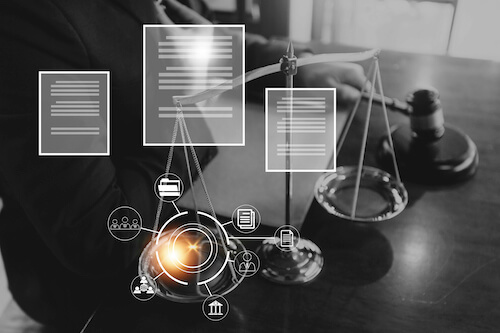Importance of Email Archiving for eDiscovery and Legal Holds
Discover the importance of email archiving for eDiscovery and legal holds, including compliance, security measures, and choosing the right solution.
-3.png?width=250&height=33&name=Untitled%20design%20(18)-3.png)
Discovery is the first stage of litigation where the legal parties in a dispute provide pertinent information, records, ...
Discovery is the first stage of litigation where the legal parties in a dispute provide pertinent information, records, and other relevant evidence to each other. Short for electronic discovery, eDiscovery involves all forms of electronically stored information or ESI.
The cloud stores over 60% of corporate data, making eDiscovery litigation a common occurrence. Legal eDiscovery software has become an essential tool for law firms to ensure they execute discovery efficiently, accurately, and completely.

The Electronic Discovery Reference Model answers the question, "What is eDiscovery in law?" The EDRM provides the framework that summarizes the basic stages of eDiscovery. The best eDiscovery law firms use the EDRM to strategize how they collect and manage ESI.
Information governance involves the examination of all current data storage to prepare for discovery. When conducting data inventory, the following steps should occur.
Determining who will oversee the eDiscovery process is important for ensuring coordination, leadership, and organization. The oversight authority may be a single person or a group of experts.
The oversight authority should then determine relevant data key terms, inventory requirements, data assets, departmental assets, and any government records definitions. The data inventory plan should include required metadata, necessary deadlines, overall procedural guidelines, and performance metrics. The plan helps legal teams assess their progress and the quality of data collection throughout discovery.

Key players should organize and describe the data assets within their departments. Cataloging data reduces redundancy and increases efficiency during legal eDiscovery.
The oversight authority should continually perform quality checks and establish which data sets should remain private or publicly available.
The data governance team should determine the priority and scheduling of data releases based on case strategy, public demand, and departmental priorities.
In short, data inventories should streamline data collection by providing transparency on the current systems the company utilizes and the type of data it collects. Every department should have a role during data inventory to make the process complete, accurate, and relevant.
When identifying the relevant ESI for legal proceedings, confirm the following to ensure the evidence you find is permissible in court and strengthens your case strategy.
Determine the holders of electronic evidence relevant to the issues for the case. To find ESI, figure out who creates and stores electronic information.
Find out what ESI the key players created. ESI can be any form of electronic information, including:
The forms of ESI become especially important during production, which occurs after collection, analysis, and review.
Knowing digital storage locations jumpstarts the legal eDiscovery process. A company might store ESI in the cloud, within the enterprise’s network, or even on backup hard drives and removable media. When you know exactly where to look for data, you maintain efficiency and relevancy throughout the discovery process.
Prior to starting data collection, legal teams should discuss the time window when pertinent data was likely created. Specifying a time can prevent unintentional data destruction or manipulation and increase data accuracy.

The duty to preserve ESI arises when a legal party reasonably foresees that the information may be relevant to future litigation. Thus, data preservation becomes a necessity once legal parties identify sources of potentially pertinent ESI. Both legal parties must then ensure that they protect ESI from tampering, editing, and destruction.
Per the Federal Rules of Civil Procedure, both parties must produce evidence spontaneously and upon request. An enterprise must preserve data before production. A court can even bind non-parties to the duty to preserve if it determines that the preservation of non-party data sets is necessary.
To ensure integrity, data management should involve the following:
Maintaining authenticity allows electronic evidence to be permissible in court.
Parties must meet as soon as possible to provide electronic evidence. The tightened window for legal eDiscovery necessitates the need for efficient and accurate data collection. The collection process involves the extraction of relevant ESI from the original source into a separate and secure repository for document review.
To ensure that data collection is reliable, legal teams should understand everything about the information-systems architecture of an enterprise, including the policies for data retention and destruction and the custodians who handle relevant ESI. Successful eDiscovery case law teams map out digital storage locations and data handling, and they also draft defensible review procedures.
Data accuracy is the key element of data collection. The use of automated tools helps to maintain accurate data collection.
With the help of artificial intelligence, search engines can quickly filter massive amounts of data to reduce inaccuracies. This reduction helps legal teams prioritize what ESI they should review first.
Automating the eDiscovery workflow reduces the mistakes that can occur from manual task management.
Moving ESI to secure cloud platforms can make data collection easier by decreasing the number of places to comb through for relevant data. Cloud platforms can also utilize sophisticated AI software to keep data organized and scalable.
After data collection, legal teams process the collected information. This involves reducing and analyzing electronic evidence to prepare the ESI for attorney review. The teams deduplicate data and remove meaningless files.
There are legal eDiscovery software systems with analysis tools to help comb through data for relevant terms and visual data tools to help legal teams oversee data processing and develop a complete picture of the current evidence. IT teams can customize these systems with search terms, time window restrictions, and technology-assisted reviews.
After data processing, electronic evidence is subject to document review. Depending on the case strategy, legal teams evaluate the collected evidence to determine if the data is relevant and strengthens their case. An in-house team and outside party should conduct a review of the evidence to ensure that they appropriately examine all the necessary ESI.
Following document review, the eDiscovery team will convert the electronic evidence into the agreed form of production. The form of production should be authenticated, data should be searchable and sortable, and changes should be transparent.
The rules of evidence are the rules by which a court determines that certain evidence is allowable in trial. Two main sources of law govern electronic evidence.
The Fourth Amendment of the U.S. Constitution protects individual privacy interests by prohibiting unreasonable searches and seizures. Law enforcement is typically only allowed to seize and search an individual’s property with a valid search warrant. A court may deem that unlawfully gathered evidence is impermissible. For example, if law enforcement utilizes hacking techniques to capture incriminating ESI, the evidence may not be permissible.
There are two statutory privacy laws worth mentioning: The Electronic Communications Privacy Act and the Patriot Act. The ECPA governs how the government and law enforcement may conduct electronic surveillance and obtain ESI from network, internet, cellphone, and satellite service providers.
The Patriot Act expanded the power of law enforcement to collect electronic evidence in addition to physical evidence.
To be admissible in court, electronic evidence should be authentic, accurate, complete, and convincing to the jury. Relevant parties should closely follow legal procedures during eDiscovery to prevent a court from labeling evidence as impermissible.
There are many other regulations, laws and guidelines which might affect your business. Take a look at this blog for more information.
The biggest challenge with eDiscovery is the sheer amount of data that can be involved. Unlike physical storage and hard drives, which have set storage limits, cloud-based storage can be almost limitless. Massive amounts of data make it difficult for legal teams to find the critical information they need to strengthen their case strategies.
There are several ways to overcome eDiscovery challenges:
Using these tools and techniques can make eDiscovery more manageable, particularly when dealing with large volumes of data. Legal teams can dedicate more time to analysis and review with the help of AI and automated tools.

How your company conducts eDiscovery can have significant legal and financial implications. There are three main guidelines for navigating the eDiscovery process.
While the EDRM provides a framework to follow, legal teams should customize the overall process to meet the needs of their case strategies. They should also initiate eDiscovery quickly, even if the case is dismissed.
Legal parties are responsible for scheduling the eDiscovery conference as soon as possible to determine what data they should preserve and what the final form of production should be. Knowing these two things allows legal teams to conduct data collection in a manner best suited to the case.
Utilizing eDiscovery software systems, such as Microsoft Purview, or Expireon, can drastically increase the efficiency and accuracy of finding relevant ESI. With built-in analysis tools, legal teams can ensure that they have collected all necessary ESI and ensure that their evidence is permissible in court. To take full advantage of these software systems, converting your enterprise to a cloud-based platform is a top priority.
Being ready for the possibility of a legal case is the best way to ensure that your electronic information is primed for eDiscovery. Converting your enterprise to a cloud-based platform allows your IT and legal teams to utilize eDiscovery software to streamline the discovery process.
At Cloudficient, we use unmatched next-generation migration technology to help our customers migrate to the cloud, which can revolutionize the legal eDiscovery process. Our business remains focused on your needs, and we customize our product offerings to meet them. If you would like to learn more about how to bring Cloudficiency to your migration project, contact our team today.
Discover the importance of email archiving for eDiscovery and legal holds, including compliance, security measures, and choosing the right solution.
Automate and centralize your legal hold workflows to reduce risk and increase efficiency. Discover why legacy methods fall short and how modern...
Creating an Office 365 eDiscovery legal hold is fairly easy. However, there are variations for types of holds and many other things to know.